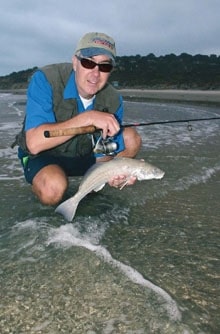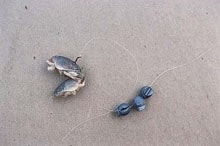
|| |—| || |’BINA TOWN: This corbina, caught in San Diego, fell for a sand crab. Photo: Zack Thomas| My first taste of corbina fishing came a couple of years back, when I accompanied angler and San Diego-based outdoor writer Paul Sharman on a trip to Torrey Pines State Beach. In the chilly gray of 5:45 a.m., we slipped on old running shoes and surf trunks and bundled up in fleece from the waist up. We timed our arrival to coincide with a minus tide, which revealed the troughs, cuts and holes on which we’d focus our efforts later in the morning.
Just a few yards south of where we first reached the water, in the wet sand beside a receding wave, we came across a field of distinct vees. Digging quickly down three or four inches at the point of a vee, I felt the wriggling of a sand crab. After digging about a dozen baits apiece, Sharman and I worked our way up the beach.
Corbina Arena
In SoCal’s surf-fishing circles, California corbina are a favorite target. The fish, a member of the croaker family, shares much in common with the bonefish: a propensity for feeding in skinny water; a taste for crustaceans; and astonishing speed and power. Corbina bite best during the summer from mid-July through late September. Summer also brings smaller surf and clearer waters. Corbina can be caught at any time of day, but they seem to feed more actively during the low-light hours.
With corbina, working the inside waves and sight-casting is often more productive, and more fun, than launching blind casts. Corbina often ride the wash into areas that will be high and dry in a few seconds to root morsels out of the sand in just inches of water. It takes a quick and accurate cast to drop a sand crab two or three feet ahead of these feeders, but if you can do it, hold on-these fish have been known to make blistering runs.
Since long casts aren’t necessary, and since corbina are notoriously line shy, a light-tackle spinning outfit spooled with four-pound line is ideal. I prefer a 61⁄2- to seven-foot rod with a soft tip and a fairly powerful midsection, as it allows me to cast light baits but still gives me some stopping power.
Most anglers use a Carolina rig-a small barrel swivel with a plastic bead below a 1⁄4- to 1⁄2-ounce bullet sinker. A three-foot leader tied to the swivel ends with a No. 6 or 8 light-wire octopus hook that is best for sand crabs, which are about the size of a grape. Pass the hook up through the underside of a whole crab and out through the shell on its back. While sand crabs are definitely a corbina’s favorite meal, a bloodworm, ghost shrimp or clam (all on the same Carolina rig) do the trick as well. Berkley Gulp! sand crabs are almost as good as the real thing, and a number of sand crab-imitating patterns are available from SoCal shops for the fly-rod crowd.
Casting Director
When you spot a fish in the wash, the challenge is to place your bait within its field of vision without spooking it. The casts are often shorter-usually just ten to 25 feet-but the fast-moving water doesn’t help. Take into account the direction the fish is swimming and the direction it’s being carried by the wash. Often, after a well-placed cast, you can see the fish take the bait. Give the fish a few seconds before setting the hook.
If fish aren’t feeding high on the beach, target holes, troughs and cuts in two to six feet of water. Get to the beach at low tide and locate some of the larger areas to be worked later. Otherwise, look for dark patches and areas of calmer water in the suds. Troughs, revealed by swaths of darker water running roughly parallel to the beach, are particularly productive.
Cast to these areas from as far away as reasonably possible-say, 30 to 50 feet-and let the wave action tumble your bait around freely. The trick is to keep your line tight enough to detect pickups without making your bait appear unnatural. Fish with your rod tip high and keep moving along the beach, checking your bait and recasting every minute or two. This isn’t sit-and-wait surf fishing; it’s common to cover a mile or more of beach in a morning.
Caught on Fire
It wasn’t until two weeks later that I caught my first corbina. I landed my second and third, too, and my wife got her first. We kept one of our four fish for dinner and grilled the fillets over open coals.

| |GRAPE BAIT: Sand crabs, each about the size of a grape are deadly on corbina. Photo: Tom Waters| And, as we enjoyed the meal, we discovered something corbina and bonefish don’t have in common: corbina are about as good to eat as a fish gets.
Get Digging
A corbina’s favorite cuisine is buried right beneath your feet.
Sand crabs are the preferred prey of California corbina, but since they’re tough to keep alive in captivity, few bait shops sell them. Fortunately, it’s easy to dig up a fishing day’s worth on beaches where corbina are caught.
Walk the beach just below the highest reach of the waves, looking for areas of vee-shaped marks in the wet sand. The vees are usually six inches to a foot long with their points facing inland.
The crabs are usually buried one to four inches below the point of each vee. Dig for them with your bare hands, scooping until you feel the crab wriggle. Or scour the sand with a garden trowel and pick out the crabs as you go. Keep the crabs in a small container with some sand and seawater, freshening the water every half-hour. – Z.T.









